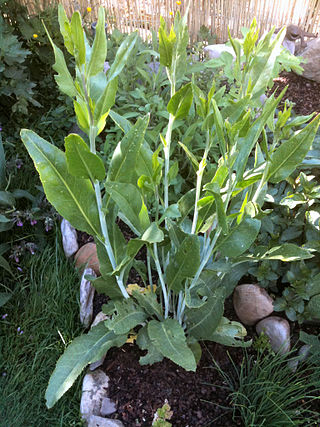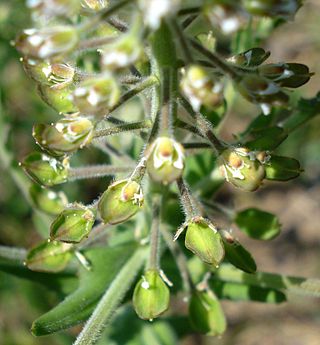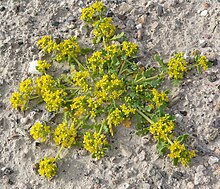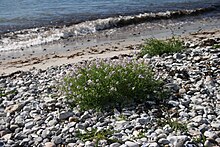
Cress, sometimes referred to as garden cress to distinguish it from similar plants also referred to as cress, is a rather fast-growing, edible herb.

Lepidium latifolium, known by several common names including perennial pepperweed, broadleaved pepperweed, pepperwort, or peppergrass, dittander, dittany, and tall whitetop, is a perennial plant that is a member of the mustard and cabbage family.

Lepidium campestre, the field pepperwort, field peppercress, field peppergrass, field pepperweed or field cress, is usually a biennial with some form of annual plant in the Brassicaceae or mustard family, native to Europe, but commonly found in North America as an invasive weed. The most notable characteristic of field pepperweed is the raceme of flowers which forks off of the stem. These racemes are made up of first small white flowers and later green, flat and oval seedpods each about 6 mm long and 4 mm wide. Each seedpod contains two brown, 2.5 mm long seeds.

Lepidium virginicum, also known as least pepperwort or Virginia pepperweed, is an herbaceous plant in the mustard family (Brassicaceae). It is native to much of North America, including most of the United States and Mexico and southern regions of Canada, as well as most of Central America. It can be found elsewhere as an introduced species.

Coronopus is a synonym for the accepted genus name Lepidium. It was applied to some species of flowering plants in the cabbage and mustard family Brassicaceae known commonly as swinecress or wartcress. These are generally low spreading annual herbaceous plants with many long stems, deeply lobed leaves and small white flowers. They have a strong scent, smelling like garden cress, Lepidium sativum, when crushed. Lepidium squamatus may be native to the Mediterranean but Lepidium didymum may be native to South America. Both species are widespread weedy introduced species in other areas.

Lepidium densiflorum is a species of flowering plant in the mustard family known by the common names common pepperweed, prairie peppergrass, elongate peppergrass, hairy-fruited peppergrass, and large-fruited peppergrass.

Lepidium flavum is a species of flowering plant in the mustard family known by the common name yellow pepperweed. It is native to California, Nevada, and Baja California, where it grows in the Sonoran and Mojave Deserts. The species epithet flavum is Latin for yellow and indicates its flower colour.

Lepidium montanum is a species of flowering plant in the mustard family known by the common names mountain pepperweed, mountain peppergrass, mountain pepperwort, and mountain pepperplant. It is native to western North America from Oregon to Montana to northern Mexico, where it can be found in a number of habitats, often on salty or gravelly soils. There are several varieties, many of which are difficult to distinguish.

Lepidium perfoliatum is a species of flowering plant in the mustard family known by the common names clasping pepperweed and perfoliate pepperwort. It is native to Europe and Asia and it can be found in other parts of the world as an introduced species.

Lepidium dictyotum is a species of flowering plant in the mustard family known by the common names alkali pepperweed and alkali pepperwort.

Lepidium barnebyanum is a rare species of flowering plant in the family Brassicaceae known by the common names Barneby's pepperweed, Barneby's pepper-grass, and Barneby's ridge-cress. It is endemic to Utah, where there is a single population in Duchesne County. It is a federally listed endangered species of the United States.

Lepidium papilliferum is a rare species of flowering plant in the mustard family known by the common names Idaho pepperweed and slickspot peppergrass. It is endemic to Idaho in the United States, where it is mostly limited to a specific habitat type in the southwestern part of the state. It was federally listed as a threatened species in 2009.

Hesperidanthus suffrutescens is a species of flowering plant in the mustard family. Its synonyms include Glaucocarpum suffrutescens. When placed in the genus Glaucocarpum, it was the only species. It is a rare species known by the common names toad-flax cress, shrubby reed-mustard, Uinta Basin waxfruit and waxfruit mustard. It is endemic to Utah in the United States, where it is known only from Duchesne and Uintah Counties. It is threatened by habitat degradation and destruction. It is federally listed as an endangered species of the United States.

Lepidium ruderale is species of flowering plants in the mustard or cabbage family, Brassicaceae. It is native to temperate Asia and northern and eastern Europe. It has also naturalized in southwestern Europe and North America. Its common names include roadside pepperweed, narrow-leaved pepperwort, narrow-leaf pepperwort, and peppergrass.

Lepidium heterophyllum,, is a species of flowering plant in the mustard family which is native to parts of western Europe, growing in shingle banks, wasteland or cultivated fields.

Lepidium coronopus,, is a species of flowering plant in the mustard family which is native to parts of Africa, western Asia and Europe, growing in shingle banks, wasteland or cultivated fields.
Lepidium monoplocoides, the winged peppercress, is a nationally endangered plant species endemic to inland south-eastern Australia. The winged peppercress can grow from 15 up to 20 centimetres tall. This plant has long, slender leaves. Because of destruction of habitat, this plant is endangered. The winged peppercress has green-brown flowers which grow at the end of stems.

Lepidium foliosum, commonly known as leafy peppercress, is a shrubby species of plant found in southern regions of Australia, usually close to the coast. The herbaceous species is shrubby in form, with hairless leaves and stem, and resembles others plants of the mustard family Brassicaceae.




















